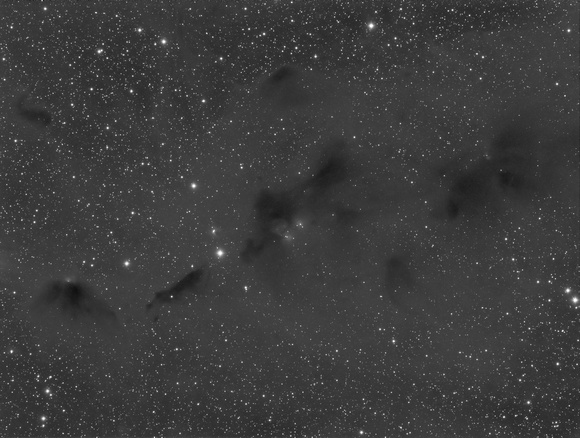LDN 1535 is the dark nebula in the bottom left of the image. It (and this whole image) is only a small part of the much larger Taurus dark cloud. DG 37 (LBN 812) is the brighter area near the image center.
This whole area is really faint, and I had to go a bit overboard with the Carboni noise reduction actions to get something that does not induce eye cancer. I really should have lowered the CCD temp and increased the exposure time.
This image was part of a workday outing (Monday night) to send my new telescope through its paces (more on this later). As much I hate doing an all nighter out in the cold between workdays, if I hadn't done this on Monday night, I most likely would have had to wait another three weeks for these images.
Date: October 28, 2014
Time: 0:01 am - 3:00 am
Camera: SBIG STF-8300M
CCD Temperature: -5 C
Optics: Televue 127is (reduced)
Filter: Astronomik L
Light frames: 30x5 min
Dark frames: 50
Flat frames: 50
Bias frames: 100
Binning: 1x1
Guiding: Orion SSAG @ Orion finder (~162 mm)
Mount: AP Mach 1
Dithering: Manual
Processing: Stacking in CCDStack, Curves, Levels, and noise removal actions in PSCS6.
Other notes:
I was worried that the Mach 1 would be a bit upset with the larger payload of the new telescope but I was (fortunately) dead wrong. Over the course of three hours, I consistently had lt;0.5" rms guiding error on all images without a single outlier. The mount put on a jaw dropping performance.
On my way home I saw a bobcat about a 3 minute drive from where I was set up. I'm glad I didn't become his dinner.
As I mentioned above, this was taken with a new telescope and I wanted to use this space to give a quick explanation of how I chose the scope as I see many people online who choose their telescopes in a 'romanticized' way.
The Tak 90 was great, but I wanted more focal length to make galaxy imaging more accessible, while still getting a whide field. I was aiming for anything between 500 and 750 mm focal length.
I started by assembling a list of telescopes that were within my budget and that worked at the focal length of interest. Once I had that list, I removed the price tag from the telescopes (a scope that is 40% cheaper does not earn bonus points). Next, I made a list of 'deal killers'. They are:
1. Scope shows diffraction spikes.
2. Scope shows false color
3. No support for scope in USA
4. No dedicated reducer/flattener from the manufacturer (with a full system chart and specs)
5. Too fast (lt;f/3.6)
6. Too slow (gt;f/5.2)
These criteria eliminated the following scopes (criterion in parentheses):
TEC140 (4), TMB130 (4), Borg 125 (2), APM130 (3), AstroTech130 (4, 5), StellarVue130 (4), ASA 8" (1, 5, [2?]), Intes MN74 (3), Pentax125SDP (3),
leaving me with the following options:
Televue 127is, Astro Physics 130, Takahashi TOA 130.
The 127is seemed the most attractive of the bunch (integrated flattener, fully designed for imaging), with the AP130 a close but clear second (you need to buy a separate flattener for photography), and the Tak 130 a distant third (huge moment arm).
The next thing to decide is which flavor of the TV127is would be best - the 5053 or the more recent (but not latest) 5054. The internet couldn't give me a clear answer, so I phoned Televue, and I was immediately forwarded to the man himself - Al Nagler (founder and CEO of Televue). Over the course of 10 minutes he answered all my questions in great detail, and I concluded that the differences between the two flavors were minor.
The next challenge was to find this scope on the used market. Over the course of my scope hunt I saw three AP130s and another three TAK130s change owners, while only one owner offered his 127is which sold in a flash, but not to me. I must have had my add up for a month before I found a seller.
Once the scope was in hand, I had to wait for the weather to clear, and that was fine since I had to deal with two more tasks.
The first task was to once and for all hunt down the source of a diagonal pattern noise (diagonal banding) in my images. I have a write up of that
here.
The second task was to decommission my old scope - the Tak 90. I found this to be impossible to do in a economical fashion (the scope has a minor defect in the coatings), so instead I sold the imaging accessories and my 10x70 Fujinons to raise some money so I can convert the Tak 90 into a grab and go visual scope. This was dead simple, and the setup saw first light during the partial solar eclipse.


